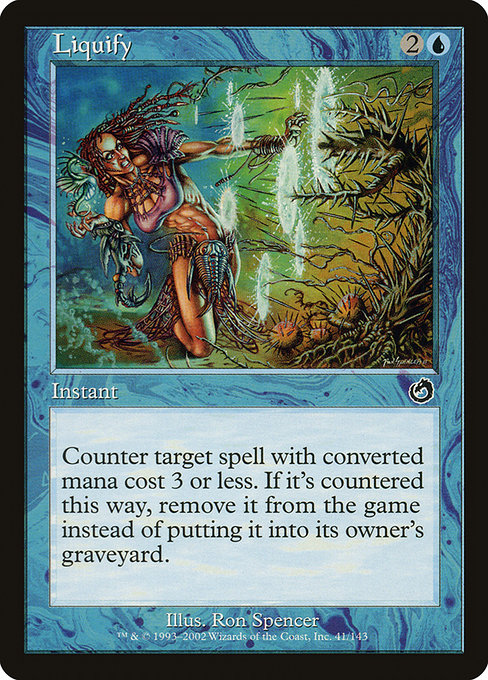
Image courtesy of Scryfall.com
Liquify and the Blue Counterspell Tradition in MTG History
In the blue corner of early-2000s MTG, a simple, efficient instant emerged from the Torment set and became a touchstone for how players understood tempo, control, and the odd little thrill of exiling a spell instead of letting it linger in the graveyard. Liquify, with its modest mana cost of {2}{U} and its status as a common, didn’t shout for the spotlight the way rare mythics sometimes do. Yet its design captured a quiet elegance that blue mages have chased since the days of Counterspell—and it did so with a distinctly Torment-era flavor 🧙♂️🔥. This was a period when the color pie emphasized precise disruption and the occasional moral gray area of exile that felt both thematic and practical for players who liked to out-think their opponents at the table.
Liquify’s text is crisp: “Counter target spell with mana value 3 or less. If that spell is countered this way, exile it instead of putting it into its owner's graveyard.” The dual-layered impact—deny the spell, and then banish it from the game—gave blue a reliable tool against the flood of cheap, flashy plays that defined many formats of the era. The restriction to mana value 3 or less keeps Liquify in the tempo-strategy lane rather than letting it become a universal counter, and that specificity is part of its charm. It’s the kind of card that rewards careful sequencing and reading of the board state, a hallmark of the blue archetypes that fans love to debate over at league night 🎲.
“Counter target spell with mana value 3 or less. If that spell is countered this way, exile it instead of putting it into its owner's graveyard.”
From a lore perspective, Torment painted a darker, more mature corner of the Multiverse, where blue often shone through with a cool, calculating mindset. Liquify fits that ethos: a precise operation that seeks to erase problems before they grow into bigger threats. The card art by Ron Spencer captures a moment of counterplay in motion—a ripple of magic, a flick of the wrist, and a spell that splashes into the void. The result is a piece that feels like a snapshot of a duel: the moment when a plan comes together, or when a plan folds into exile. It’s that blend of strategy and flavor that makes Liquify feel like a historical touchstone rather than just a line on a card list 💎⚔️.
In practice, Liquify is a reminder of how early blue control could be economical and cunning. Its existence alongside other Torment blue staples—cards that pulled the strings behind the scenes—helped shape how players thought about tempo, resource denial, and the long game. It’s also a nostalgic link to the era when the community debated about whether exile was a better fate for a countered spell than simply discarding it to the graveyard. The exile clause gives Liquify a unique edge in formats where graveyard interactions mattered, even if it remains a common rarity—a reminder that strong decisions can come from unassuming cards 🎨.
Collectors will note that Liquify appeared in the Torment:Set (Tor) with the typical Torment flavor of shadowy, reflective magic. The card’s blue identity is reinforced by its cost and effect, and its foil versions provide a gleam that contrasts nicely with the black-and-white world of Torment’s art direction. Even though it’s not a top-tier chase card, its value as a historical artifact is undeniable: a concrete example of how blue’s control toolkit evolved from the late 1990s into the early 2000s, and a tangible reminder of the era’s design philosophy. For players revisiting their old collection or teaching new generations about the roots of blue control, Liquify serves as a perfect talking point during a night of nostalgia and footnotes 🧙♂️🔥.
Strategic takeaways for modern play
- Targeted disruption: Liquify isn’t the catch-all counterspell for every situation, but its limitation to spells with mana value 3 or less makes it a precise answer to early threats and low-cost combos. In a world of escalating mana costs and longer games, that targeted precision can still be a powerful tempo move 💥.
- Exile as a blade: The exile clause can tilt matchups away from graveyard-based recursion. If your metagame features strategies that rely on reanimator or spell-based draws, Liquify’s exile adds a layer of inevitability that a plain counter rarely achieves ⚔️.
- Flavor meets function: Torment’s vibe—pale light and shadowed decisions—shines through Liquify. It’s a reminder that a card can be both mechanically clean and thematically sharp, a balance that modern designers still chase when crafting new counterspells and control tools 🔥.
As we thumb through older sets, Liquify stands as a compact monument to the elegance of early blue control. It’s not the loudest card in the room, but it reminds us that magic—like good design—often speaks softly and carries a lot of strategic weight. And in a hobby where the history of a card can color how you view a modern play, Liquify is a perfect little lighthouse for fans who love the story behind the spell, the art, and the era that gave it its first shine 🧙♂️🎨.
Speaking of tactile joys and collector’s items, if you’re setting up your next game night or just basking in the glow of your old-school mana curves, consider keeping your setup stable and stylish with practical gear on the table. For a handy, everyday-use accessory that helps you keep a steady grip on your devices, check out the product linked below. It’s a friendly nod to the modern MTG table—the kind of small upgrade that makes long multiplayer sessions feel a little smoother and a lot more fun.
phone grip click on reusable adhesive holder kickstand
More from our network
- https://transparent-paper.shop/blog/post/unusual-red-hue-in-a-hot-star-on-the-color-magnitude-diagram/
- https://transparent-paper.shop/blog/post/how-to-sell-after-effects-templates-for-passive-income/
- https://crypto-acolytes.xyz/blog/post/meta-blockchain-explained-what-it-is-and-why-it-matters/
- https://blog.digital-vault.xyz/blog/post/blue-white-beacon-in-mensa-reveals-temperature-via-color-indices/
- https://crypto-acolytes.xyz/blog/post/how-tokenomics-shapes-modern-game-design/